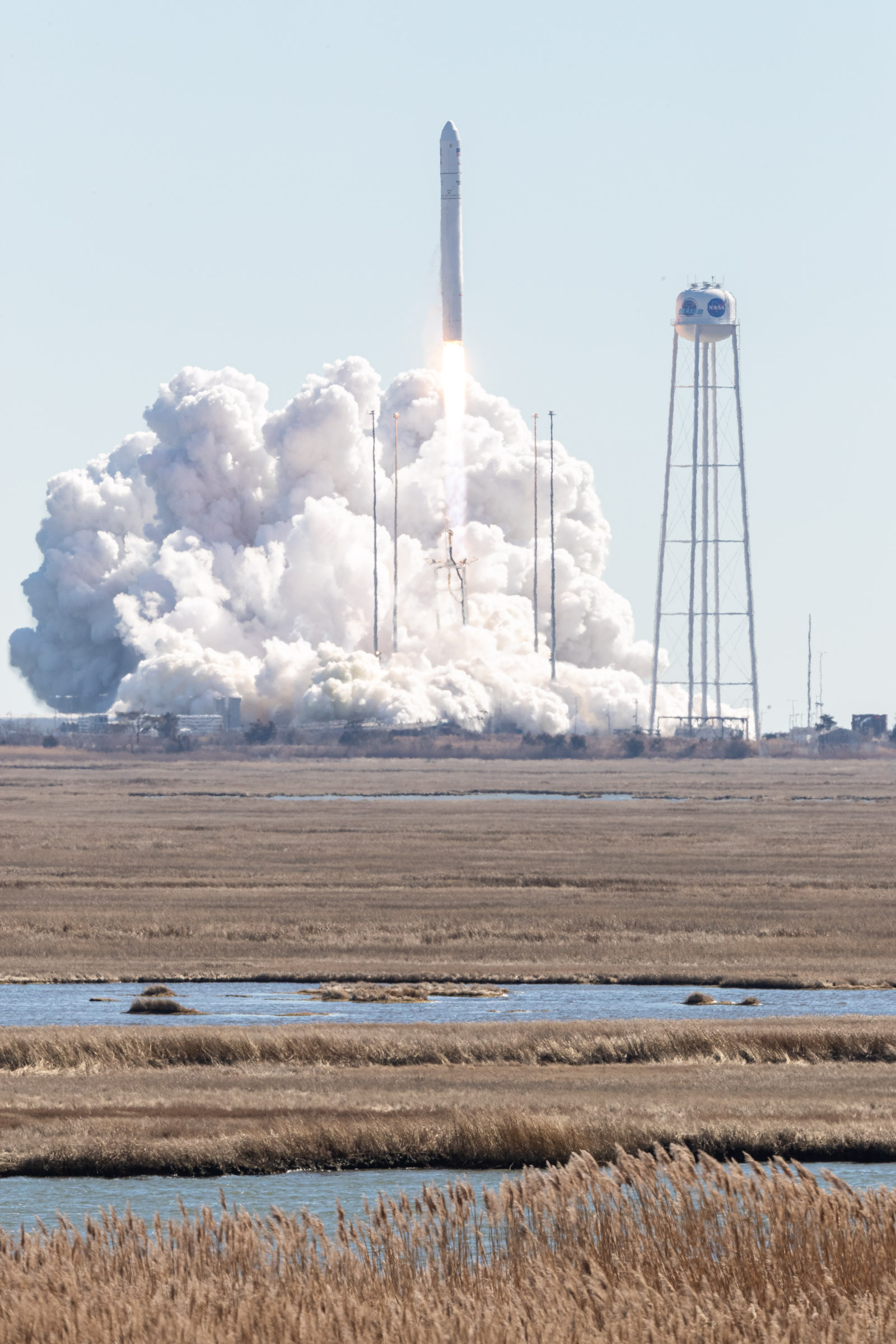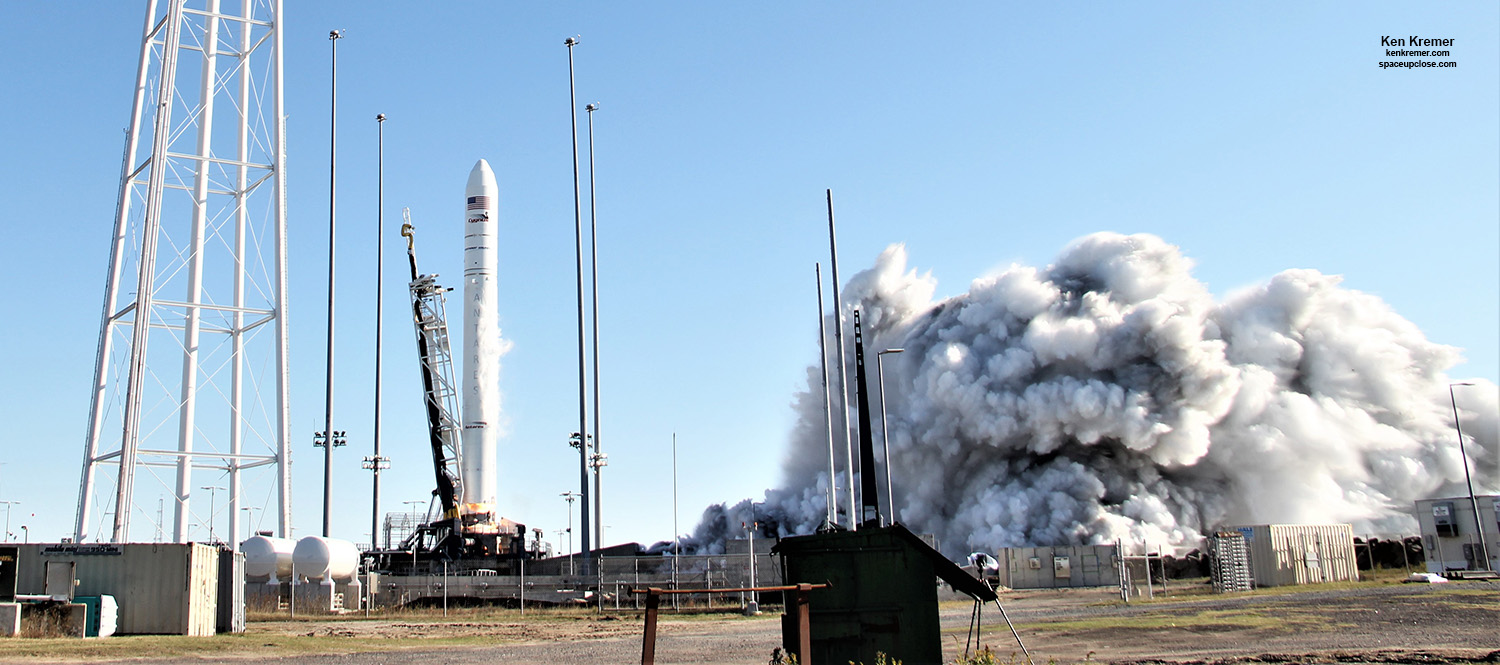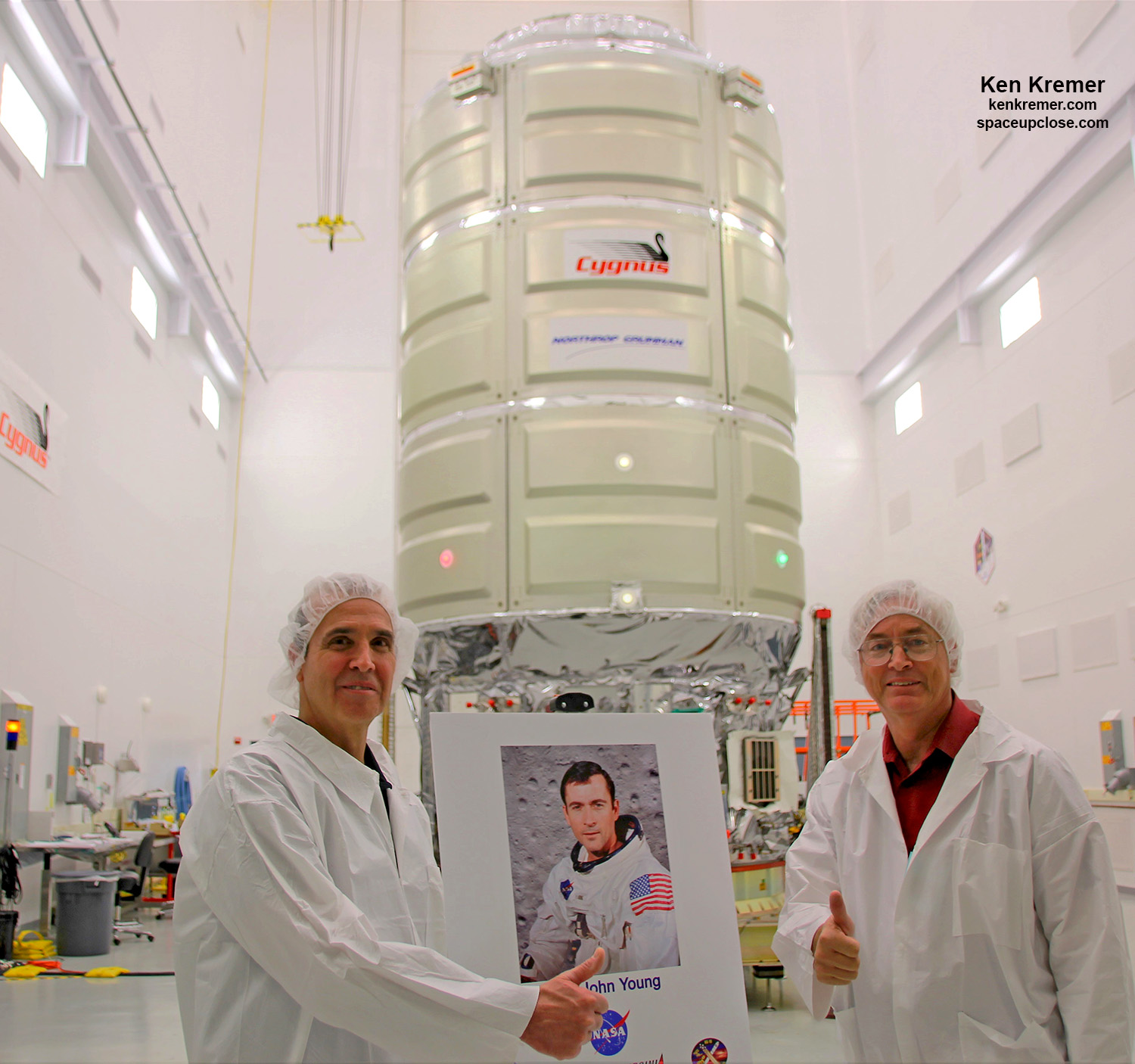
For SpaceUpClose.com & RocketSTEM
CAPE CANAVERAL, FL – A Northrop Grumman Antares rocket launched from NASA’s Wallops Flight Facility in Virginia at noontime Saturday, Feb. 19, carrying the firms Cygnus commercial cargo craft loaded with over 4 tons of NASA science and supplies bound for the International Space Station (ISS) and its seven person international crew from the US, Russia and Germany.
The flawless liftoff of the Antares rocket and Cygnus resupply ship took place right on time at 12:40 p.m. EST from pad 0A at 12:40 p.m. EST from NASA’s Wallops Flight Facility in Virginia, on Feb. 19, 2022.
The Cygnus space freighter mission designated as NG-17 is packed with a fresh supply of 8,300 pounds of NASA scientific investigations, cargo, supplies, food, water, space parts, gear and more for a two day trip to the ISS.
The #Cygnus spacecraft is safely in orbit with solar arrays extended. Treats and tasks await the astronauts upon arrival at the @Space_Station, which is set for Feb. 21. Kayla Barron & @Astro_Raja will work together to guide Cygnus into place: https://t.co/BEsJA2XGyb pic.twitter.com/GdCulb5O7k
— NASA (@NASA) February 19, 2022
Cygnus successfully achieved preliminary orbit and unfurled its life giving cymbal-shaped solar arrays.
The @NorthropGrumman #Cygnus space freighter's cymbal-shaped solar arrays have deployed powering the cargo craft as it heads to the station for a Monday morning capture. https://t.co/9tyicL8jt3
— International Space Station (@Space_Station) February 19, 2022
Watch this replay of the picture perfect blastoff from NASA Wallops which was carried live on NASA TV
The @NorthropGrumman Antares vehicle lifted off from Wallops at 12:40 p.m. ET carrying the Cygnus spacecraft carrying 8,300 pounds of cargo & research to the @Space_Station! 🚀 pic.twitter.com/6iHEBOmdM1
— NASA Wallops (@NASAWallops) February 19, 2022
This counts as the 6th successful blastoff of the upgraded 230+ version of the Antares rocket.
The first stage is built in the Ukraine by Yuzhnoye State Design Office and Yuzhmash Machine Building plant and is powered by the Russian-made RD-181 engines from Russia’s NPO Energomash and fueled by LOX and RP-1.
Thus Antares is sourced from the area of current global tensions exactly where war could break out at any moment – but hopefully remains peaceful.
“We’re obviously monitoring the situation and hopefully it can be resolved,” said Kurt Eberly, director of space launch programs for Northrop Grumman Launch and Missile Defense Systems, at the Feb. 18 prelaunch briefing.
Northrop Grumman officials confirmed at a prelaunch NASA briefing for reporters that they have enough cores and engines for at least the next two Cygnus resupply missions namely NG-18 and NG-19.
This NG-17 launch marks Northrop Grumman’s 17th contracted resupply mission under the second Commercial Resupply Services (CRS-2) contract with NASA.
“The best mitigation we can have is to be buying ahead,” Eberly said. “Hopefully, that will tide us over until these tensions can subside and we can be back to normal operating procedure.”
Cygnus will carry out a carefully choreographed series of thruster firings to reach the vicinity and rendezvous with the space at around 4:35 a.m. on Monday, Feb. 21. NASA Television, the NASA app, and agency’s website will provide live coverage of the spacecraft’s approach and arrival beginning at 3 a.m.
.@NASA TV is live Monday at 3am ET as two @NASA_Astronauts prepare to capture 8,300 pounds of cargo at 4:35am. https://t.co/KpKagFgz4F
— International Space Station (@Space_Station) February 20, 2022
NASA astronauts Raja Chari and Kayla Barron will capture Cygnus with the station’s robotic Canadarm2 upon its arrival. The spacecraft will then be installed on the Earth-facing port of the station’s Unity module.
At the prelaunch briefing I asked NASA’s ISS manager Joel Montalbano for an update about the ISS resupply contracts which run through 2023 since the station life has been extended to 2030.
Montalbano did not provide a lot of details since he said the next procurement contract bids covering 2023 to 2026 are in progress which limits what he can say but hopes to have an update soon.
“We’re buying this a little bit a yard at a time or so, working with the different providers,” he said. “My hope is that in the next month or so we can get some more public information out.”
I also asked for an update about the Sierra Space Dream Chaser mini shuttle and when it might fly resupply missions to the ISS under thye CRS-2 contract.
Montalbano replied that NASA expected the first Dream Chaser cargo mission to launch in late 2022 or early 2023 aboard the ULA Vulcan rocket.
The delivery includes critical materials to support dozens of the more than 250 science and research investigations occurring during NASA’s Expedition 66 mission aboard the space station.
Learn more about the SOFI experiment here:
One payload aboard today’s NG-17 launch is SoFIE, a new facility enabling new studies of flammability of materials, which could help ensure crew safety. https://t.co/05AHakaaQ5 pic.twitter.com/0HGaAPHIFR
— ISS Research (@ISS_Research) February 19, 2022
Cygnus is named in honor of NASA astronaut Pier Sellers, a renowned climate scientist who also helped build the ISS during his 3 space shuttle missions and who passed away in 2016.
https://twitter.com/Nanoracks/status/1495095349890924549
Another important aspect of Cygnus is that it will carry out a re-boost test of the ISS to shift it to a higher orbit like the Russian Progress vehicles currently perform.
Here is the detailed manifest of approx. 8,300 pounds (about 3,800 kilograms) of NASA cargo loaded aboard Cygnus NG-17 resupply mission for delivery to the ISS
- 2,980 pounds (1,352 kilograms) of crew supplies
- 2,883 pounds (1,308 kilograms) of vehicle hardware
- 1,975 pounds (896 kilograms) of science investigations
- 200 pounds (100 kilograms) of unpressurized cargo
- 132 pounds (60 kilograms) of spacewalk equipment
- 77 pounds (35 kilograms) of computer resources
Here is a NASA description of several of the scientific investigations Cygnus is carrying:
Protecting our skin
Deterioration of skin tissue, a normal part of aging, occurs over decades. Microgravity leads to changes in the body like aging but that occur much more quickly, so they can be more easily studied. Colgate Skin Aging will evaluate cellular and molecular changes in engineered human skin cells in microgravity. Results may help speed development of products aimed at protecting skin from the aging process on Earth.
Testing tumor drugs
MicroQuin 3D Tumor will examine the effects of a therapeutic on breast and prostate cancer cells. These cells can grow in a more natural 3D model in microgravity, which makes it easier to characterize their structure, gene expression, cell signaling, and response to the treatment. Results could provide new insight into the cell protein targeted by the drug and help advance development of other cancer drugs.
Improving hydrogen sensors
The Advanced Hydrogen Sensor Technology Demonstration will test new sensors for the space station’s oxygen generation system. Current sensors ensure that none of the hydrogen enters the cabin oxygen but can be sensitive to moisture, nitrogen, and other issues that require them to be swapped out every 201 days. This technology could provide more durable sensors for situations where rapid replacement is not practical, reducing the number of spares needed on longer space missions such as to the Moon or Mars.
Better batteries
Space Demonstration for All Solid-State Li Ion Battery (Space As-Lib), an investigation from the Japan Aerospace Exploration Agency, will feature the operation of a lithium-ion secondary battery capable of safe, stable operation under extreme temperatures and in a vacuum environment. The battery uses solid, inorganic, and flame-retardant materials that do not leak, making it safer and more reliable. Results could demonstrate the battery’s performance for various potential uses in space and other planetary environments. Solid-state batteries also have potential applications in harsh environments and the automotive and aerospace industries.
Plants in space
Current systems for growing plants in space use soil or a growth medium. These systems are small and do not scale well in a space environment due to mass, containment, maintenance, and sanitation issues. To address these issues, eXposed Root On-Orbit Test System (XROOTS) will use water- and air-based methods instead, reducing overall system mass. Results could provide insight into the development of larger-scale systems to grow food crops for future space exploration and habitats. Components of the system could also enhance plant cultivation in greenhouses on Earth and contribute to better food security.
Improving fire safety
Solid Fuel Ignition and Extinction (SoFIE) will enable studies of the flammability of materials and ignition of fires in realistic atmospheric conditions. This facility uses the Combustion Integrated Rack (CIR), which allows for testing at different oxygen concentrations and pressures that represent current and planned space exploration missions. Gravity influences flames on Earth, but in microgravity, fire acts differently and can behave in unexpected ways aboard the space station. Some evidence suggests that fires may be more hazardous in reduced gravity. Results could help ensure crew safety by improving design of extravehicular activity suits, and cabin materials, improve our ability to determine the best techniques for suppressing fires in space.
Findings from these and other investigations aboard the space station will contribute to keeping astronauts healthy during long-duration space travel and demonstrate technologies for future human and robotic exploration missions as part of NASA’s Moon and Mars efforts, including lunar missions through the agency’s Artemis program.
Cygnus will also deliver critical hardware to be installed during the upcoming ISS Roll-Out Solar Array (IROSA) spacewalks, as well as other components for the successful functioning of astronaut life on the space station, such as a trash deployer and acoustic covers for the waste management system.
….

Watch Ken’s continuing reports about ISS resupply, Mars Perseverance and Curiosity rovers, JWST, IXPE, DART, SpaceX Crew and Cargo Dragons, Artemis, SLS, Orion and NASA missions, Lucy Asteroid mission, SpaceX Starlink, Blue Origin and Space Tourism, Commercial Crew and Starliner and Crew Dragon and onsite for live reporting of upcoming and recent SpaceX and ULA launches including Crew 1 & 2 & 3, ISS, Solar Orbiter, NRO spysats and national security missions and more at the Kennedy Space Center and Cape Canaveral Space Force Station.
Stay tuned here for Ken’s continuing Earth and Planetary science and human spaceflight news: www.kenkremer.com –www.spaceupclose.com – twitter @ken_kremer – email: ken at kenkremer.com
Dr. Kremer is a research scientist and journalist based in the KSC area, active in outreach and interviewed regularly on TV and radio about space topics.
………….
Ken’s photos are for sale and he is available for lectures and outreach events
Please consider supporting Ken’s work by purchasing his photos and/or donating at Patreon:
https://www.patreon.com/kenkremer

x



